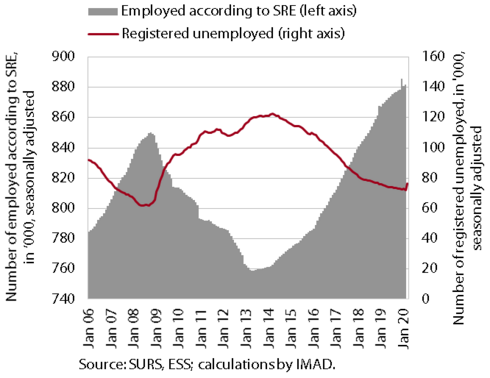Charts of the Week
Current economic trends from 14 to 17 April 2020: labour market, electricity consumption, freight transport on Slovenian motorways and others
We have extended the overview of current economic trends to data which additionally indicate the impact of the coronavirus epidemic on economic activity in Slovenia. After the adoption of measures, registered unemployment started to rise in mid-March. It has increased by 14.3% in the last four weeks. The indicators which are available for the period after the outbreak of the epidemic also point to a significant decline in activity. Freight transport has fallen by more than 40% year on year since the middle of March, while electricity consumption at the beginning of April was around one fifth lower than a year earlier.
Other data released last week do not yet cover the period during which the coronavirus started to spread in Europe and Slovenia. Wage growth in the private sector was higher year on year in the first two months, mainly owing to the increase in the minimum wage in January, while it was lower in the public sector, primarily due to a lower volume of promotions at the end of last year. The strengthening of construction activity accelerated further in the first two months. The indicators of expected activity also improved. The current account surplus in the twelve months to February totalled 7.0% of estimated GDP.
Labour market, February – April 2020

The relatively favourable labour market conditions started to deteriorate rapidly with the adoption of measures to contain the coronavirus epidemic in the middle of March. In the first two months of this year, the number of employed persons was still 1.6% higher year on year (having increased the most in construction and in transportation and storage activities), which is almost half less than in the same period of 2019. Given the shortage of domestic workers, before the epidemic, employment increased mainly due to the hiring of foreigners. In the second half of March, following the outbreak of the epidemic in Slovenia, registered unemployment started to rise rapidly. At the end of March, it was higher than at the end of February. The rapid increase in the number of unemployed continues in April. On 19 April it amounted to 85,810 according to unofficial (daily) ESS data, which is 14.3% more than four weeks before.
Electricity consumption, March – April 2020

Electricity consumption decreased with the shutdown of public life and part of production due to the coronavirus epidemic. Electricity consumption, an important indicator of economic activity, started to fall in Slovenia in the third week of March, when it was 10% lower year on year. The decline then intensified, reaching around 20% at the beginning of April. Of the selected countries shown in the graph, Italy, the first coronavirus hotspot in Europe, recorded the largest decrease (also more than 30% in a single week). In other countries, electricity consumption fell by up to 20% in a week. Germany stands out, with a fall in consumption not exceeding 10% in any week.
Freight transport on Slovenian motorways, March–April 2020

Freight transport on Slovenian motorways has declined noticeably since the declaration of an epidemic. This is attributable both to the impact of measures to contain the coronavirus epidemic (in force since 16 March) and to the restrictions adopted in other (neighbouring) countries. Since 16 March, transport by trucks, measured by the number of kilometres driven on the entire motorway network, has fallen by more than 40% year on year. As expected, transport by foreign trucks has declined more (by around 60%) and transport by domestic trucks less (by around 25%).
Wages, February 2020

Year-on-year wage growth continued in the first two months. Wage growth in the private sector was higher year on year (5.7%; last year 4.3%); amid the still relatively low unemployment and the shortage of workers, it was also attributable to January’s increase in the minimum wage according to the Minimum Wage Act from 2018. Wages rose the most in certain activities with above-average shares of minimum wage recipients (manufacturing, administrative and support service activities, trade and accommodation and food service activities). The increase in the minimum wage also contributed to wage growth in the public sector, but this was considerably lower than last year due to a lower volume of promotions at the end of the year (3.2%; last year 5.2%).
Construction, February 2020

After a decline in the middle of last year, construction activity increased towards the end of the year and intensified further at the beginning of 2020. Activity increased in all three construction segments, the most in the construction of civil-engineering works, but also in the construction of both non-residential and residential buildings.
New contracts and the stock of contracts, the indicators of future activity in construction, dropped in the first half of last year before strengthening in the second. Favourable developments also continued at the beginning of this year, before the coronavirus had spread to Europe.
Current account of the balance of payments, February 2020

The current account surplus in the twelve months to February was the highest to date, at EUR 3.5 billion (7.0% of estimated GDP). In comparison with the same period one year before, the higher surplus continued to be attributable mainly to a higher surplus in external trade in services, particularly the surplus in trade in travel, telecommunication, computer, information and construction services. The higher surplus in trade in goods reflected the strengthening of net exports of goods under merchanting. Net outflows of primary income were lower particularly due to lower net payments of income on equity. Net payments of interest on external debt were also lower. The deficit in secondary income was also down year on year, primarily on account of February’s lower VAT- and GNI-based contributions to the EU budget.
